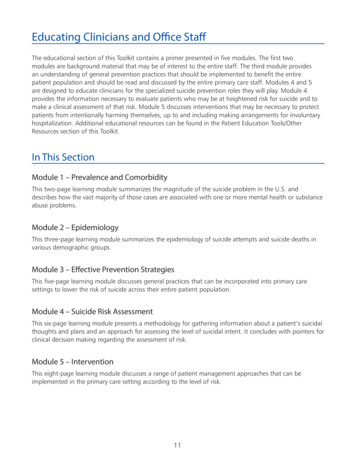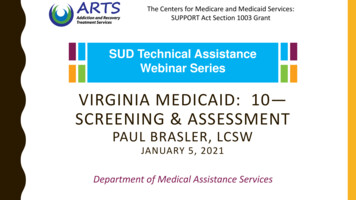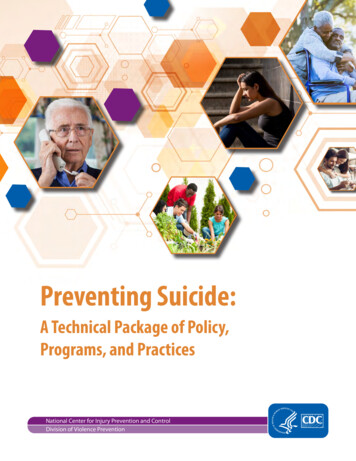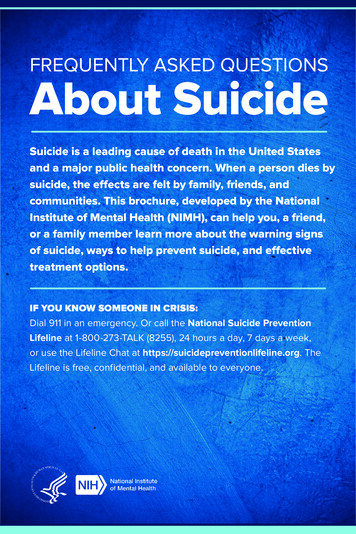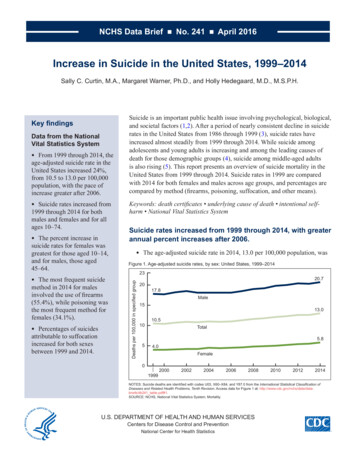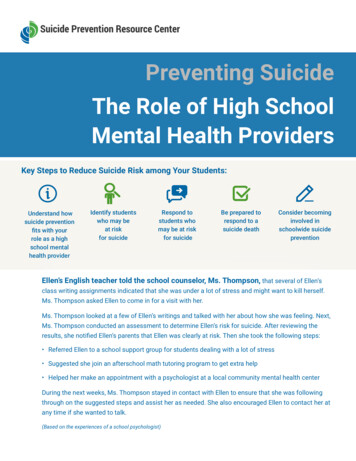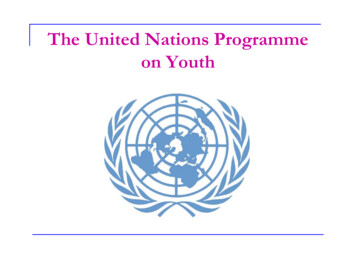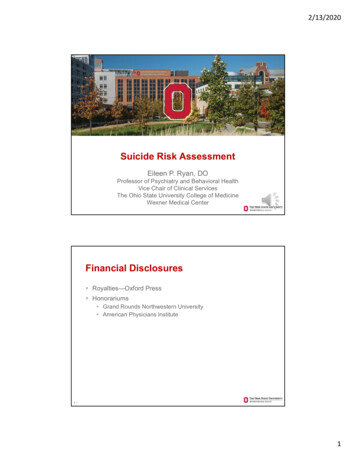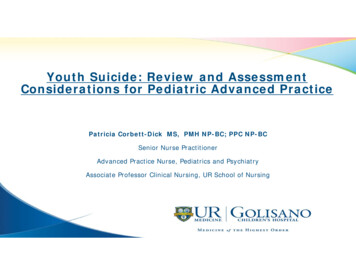
Transcription
Youth Suicide: Review and AssessmentConsiderations for Pediatric Advanced PracticePatricia Corbett-Dick MS, PMH NP-BC; PPC NP-BCSenior Nurse PractitionerAdvanced Practice Nurse, Pediatrics and PsychiatryAssociate Professor Clinical Nursing, UR School of Nursing
Objectives1. Identify the prevalence of youth suicide and riskfactors.2. Discuss potential APP roles in suicide prevention, aswell as identification and screening of at-risk youth.3. Evaluate tools and resources for mood and suicidescreening and assessment.4. Reflect on potential personal and professional biasesregarding suicide and screening for mental healthconditions.
Caution advised . Suicide is a serious topic All suicide talk is to be takenseriously and explored Practice within your scope andexperience, this is not a “how to” Get continuing education Know and use your resources
Overview:Facts, Statistics, Definitions, Myths
Youth suicide: a serious and growing problem 2016 data: adolescents and young adults aged 15 to 24 had asuicide rate of 13.2/100,000. Adolescents and young adults have lower rates than middle age,older and elder adults.www.afsp.org However, it is the second leading cause of death in 10-24 yearolds. And, some “accidental” deaths may actually represent deathswhere intent was not known, so suicide rates may be actually behigher than reported Suicide affects young people from all races and SESwww.aacap.org5
The majority of youth suicides occur in the context ofmental health disorders Most youth who attempt suicide have a significant mental healthdisorder, usually depression Other MH conditions that increase the risk of youth suicide include:eating disorders, anxiety, substance use, and disruptivebehavior disorders Most youth with MH conditions, suicidal thoughts, or a h/o suicideattempts are not receiving specialized mental health treatment Physical health problems, chronic illness, and chronic painincrease the risk of suicide6
Early identification and treatment in youth settings!!“Pediatric nurse practitioners (PNPs) and their fellow pediatric-focused advanced practiceregistered nurses (APRNs) play a key role in early detection for mental and behavioral sues in children and teens.”7
Understanding youth suicide: it’s complicated .Multiple, complex, and interrelated individual, family, school, andcommunity factors are at play. Suicide may appear to be “a solution” toproblems and distress for some youth. Younger children suicide attempts are often impulsive may be associated with feelings of sadness, confusion and anger. Teens suicide attempts may be associated with feelings of stress, self-doubt,pressure to succeed, resource uncertainty, disappointment, and loss.www.aacap.org
?9
Suicide risk and adolescent developmental tasks—“identity vs role confusion” (remember Erik Erikson) Adolescence: huge transitionbetween childhood and adulthood Remarkable individual, cognitive,emotional, mental, neurologic andsocial changes Significant opportunities for mentalhealth issues and challenges toariserisk for suicide10
2013 CDC data US Youth Risk Behavior Survey, grades 9-12Previous 12 months:% Boys% Girls Sad/hopeless every day x2 weeks in a row20.839.1 Planned a suicideattempt10.316.9 Made a suicide attempt5.410.6 Made a suicide attempt,required medical attention1.83.611
CDC data: suicide methods—15-19 g3%recent increase in rate, esp forgirls, harder to prevent inhome, more likely thanpoisoning to be fatal*Firearms in the home areassociated with higher risk ofcompleted adolescent suicide2013 CDC US Youth Risk Behavior Survey12
Suicide: female vs male differences, 15-19 yrsGirlsBoysAttempt suicideComplete suicide2x more than boys3x more than girlsWith less lethalmeans2013 CDC US Youth Risk Behavior Survey
Understanding the spectrum of self harm behaviors:Definitions from Center for Disease Control (CDC) and Self Directed Violence Non-suicidal self-directed violence: self-directed, deliberately resultsin injury or the potential for injury to oneself. There is no evidence ofsuicidal intent. Suicidal self-directed violence: self-directed and deliberately resultsin injury or the potential for injury to oneself, with evidence of suicidalintent. Undetermined self-directed violence: self-directed and deliberatelyresults in injury or the potential for injury to oneself. Suicidal intent df/Self-Directed-Violence-a.pdf14
Understanding the spectrum of self harm behaviors: :Definitions from Center for Disease Control (CDC) and Self Directed Violence Suicide attempt: non-fatal, self-directed, potentially injurious behavior, intentto die as a result of the behavior; may or may not result in injury. Interrupted self-directed violence - person takes steps to injure self but isstopped by another person or self prior to fatal injury. Other suicidal behavior/preparatory acts: acts towards making a suicideattempt, such as assembling a method (e.g., buying a gun, collecting pills) orpreparing for one’s death by suicide (e.g., writing a suicide note, giving thingsaway). Suicide: Death caused by self-directed injurious behavior with any intent to dieas a result of the /Self-Directed-Violence-a.pdf15
Fact or myth?Youth with suicidaltalk or actions areAsking aboutjust getting doingdepression orit for attention.suicidal thoughtsIf someone reallywants to commitwill give someonesuicide there isthe idea to commitnothing that cansuicide.prevent it.
Fact or myth?Myth:Asking about depressionor suicidal thoughts willMyth:Youth with suicidal talk oractions are just gettingattention.Fact:Fact:Open and supportivethoughts, and specificallyabout thoughts of endinglife are important rolesto commit suicide thereprevent it.commit suicide.teens about feelings,If someone really wantsis nothing that cangive someone the idea toAsking children andMyth:Fact:discussions are often theMost individuals withavenue for getting helpsuicide attempt orand reducing pain,thoughts do not want tosadness, stress anddie, but want their painisolation for at-risk teensto stop. Most peoplefor nurses and thosewho have attempted orcaring for or workingdied by suicide gavewith childrenwarning signs.
PreventionAccess to Care, Stigma, Risk Factors, Models
Suicide prevention goals: Reduce risk factors that aremodifiable Identify vulnerable youth Increase MH/suicide screening Improve skills for talking to youthWho can help? Youth, peers Family members, friends Nurses, NPs, all health care Teachers, school administrators,counselors Know warning signs and resources Coaches, extracurricular leaders Increase protective factors Mentors, service providers Identify targeted individual, family, Faith communitiesschool, community, medical and MHinterventions First responders Others
Mental health (MH) system realitiesMH workforce crisis, child and adol psychiatrist (CAP) data Note that child and adolescent psychiatrists are in “good supply” in thegreen states (basically, none, only Washington DC, too small on map)20
Mental health (MH) system realitiesMost referrals to MH services are never kept Factors: Stigma Insurance coverage and costs Transportation and location Wait lists and schedules Fears, shame and denial Motivation, readiness to change are not assessed Language and cultural barriers Other basic needs are more pressing (think Maslow )
Stigma: the real public health crisis Stigma: when person is viewed by others in a negative waybecause of a disability or MH condition It may be a feeling of shame or judgement by others It can come from an internal place, confusing feeling bad with being bad. People with MH conditions and or disabilities face rejection, bullying anddiscrimination Mental health conditions are the leading cause of disability across the US Delays in care are the norm, adults report typically an 8-10 year delaybetween identification of a symptom and finally getting treatment Basically, many who need treatment do not get itNational Association of Mental Illnesswww.nami.org22
Fighting stigma—but what can I do?Talk openly about mental health, normalize stress and challenges Every contact with youth, families, peers, colleaguesEducate yourself and others Continuing education, training, interdisciplinary work to grow skillsBe conscious of language Use “people first language”, don’t label youth by a diagnosis or prejorative terms;(reduce use of stigmatizing words like crazy, cuckoo, nuts, retarded; speak up)Encourage equality between physical and mental illness We get dental and medical check ups “feelings need check ups too” (AAP) We don’t blame the pt with asthma and a cold because symptoms flared up And.youth and families with behavioral disorders will surely demonstrate thebehavioral signs of their diagnosis.
Fighting stigma—what can I do? (cont’d)Show compassion for youth with mental health conditions you may be the only one who has ever provided that acceptance, you can be a role model for othersChoose empowerment over shame encourage youth to reject negative stereotypes, believe that they can achieve their life goals, take control,be active and help them be optimisticBe honest about treatment encourage and facilitate self disclosure for pt/families/self as appropriate; can you be a role model, orprovide hope? What have you overcome?Let the media know when they’re being stigmatizing for example, when the description of an individual is the symptom or diagnosis ( “autistic” “schizophrenic”“suicidal”) or, if a TV show is stereotyping negative attributes, speak up!Don’t Harbor Self-Stigma reflect on ways your own life or family experiences might affect your practice or beliefs, self -acceptance
National Alliance onMental Illness (NAMI)is an amazing advocacyorganization promoting: Education Communication Person centered care Advocacy and support Treatmentwww.nami.org
How can we improve access to care:mental health screening, early intervention in youth settings26
Improving access to care:integrated care settings are one solution27
Youth suicide risk factors*:“Fixed” risk factors, these are non- modifiable FH suicide, or suicide attempts FH parent MH problem, substance abuse Male gender LGBTQ Previous suicide attempt H/O physical or sexual abuse H/O exposure to violence Acute losses, rejection*remember risk factors are common, suicide is still uncommon
Youth suicide risk factors*:*risk factors are common, suicide is still uncommonMental illness diagnoses/other symptoms (may bemodifiable or amenable to treatments): Sleep disturbances Depression, Bipolar d/o Substance use d/o Panic d/o, PTSD, complex trauma Aggression, anger, impulsivity Psychosis* (markedly increased risk) Non suicidal self injury or suicidal ideation Preoccupation with death Disordered internet use (ie:looking at pro-suicide sites) Chronic pain, chronic illness
Youth suicide risk factors*:*risk factors are common, suicide is still uncommonRisk is also increased for youth who: Are exposed to the suicide of another: esp if school mate; esp if online or withmedia exposure** Are involved in child welfare and/or juvenile justice systems Are a sexual minority-LGBTQ (2x rate of suicidal ideation) Are American Indian or Native Alaskan males Are military service members and their children Are involved in bullying (all types) Are perpetrators and victims of bullying**NIMH has best practices for media and reporting deaths by suicide to prevent clustering of suicides30
Moving from a suicide prediction model to a preventionmodel Prediction based models Clinicians integrate risk factorPrevention based models Assess risk status compared to similarpopulation (ie: youth in outpatientinformation Try to estimate the likelihood of asettings; youth in ED; youth inpatient) Assess risk state (compared to otherrelatively rare event Rate risks as low vs medium vs high No algorithms, no data on effectiveness Subjective, with likely biasespoints in time) Identify available resources to addresscurrent crisis Identify foreseeable changes that couldincrease risk2016, Pisani et al, Academic Psychiatry
The bigpicture maximizeprotectivefactorsandminimizerisk factorsat all levelsto preventyouthsuicide32
Clinical roles and responsibilities for nurses, NPs, APPs- Emphasize building rapport, which increases willingness to talk about suicide Take all threats or suicide attempts seriously and convey concern Look for warning signs and discuss them with the youth/family Collaborate with colleagues, patient for safety planning Support youth in learning to cope with negative thoughts Involve parents, supportive family members/friends, get youth permission when non urgent Have access to referral resources such as emergency phone contacts; call 911 if a patient inthe community is agitated or seems in imminent danger of self-harm. Document assessment of risk, with rationale for interventions. If you are unsure whether a referral is necessary, err on the side of lives-preventing-suicide/33
Developing SkillsCommunication, Screening, Warning signs34
Developing skills-communicate effectively with children and teens . Work on getting comfortable with difficult topics, and stay calm Normalize talking about MH concerns with youth and families Ask, ask, ask—ask regularly about feelings, mood, stress, “dark thoughts” Normalize talking about these topics, including thoughts of death or suicide Reassure that thoughts of death or suicide are not uncommon, talking aboutthem is often a relief Actively listen, explore, reflect; don’t preach, lecture or shame Discuss limits of confidentiality with youth and parents Interview youth alone, and reassure parents you will communicate abouthigh risk situations
Developing skillssuicide specific questions, (adjust to appropriate level). Have you had thoughts about a way or plan to kill yourself? Do you have a way to do this? Do you have access to guns? Have you shared your thoughts, ideas with anyone? Do you have someone with whom you can talk about your thoughts? Have you practiced or mentally rehearsed your plan? What keeps you from carrying out your plan?36
Depression is a primary risk factor for suicide: Suicide thoughts/attempts are most often associatedwith depression Screening and referral for depression is an importantprevention strategy Screening can happen in all settings Common and easy to use screening tools for depressionare widely available37
Be aware of depressive symptoms in adolescents:AAP, 2016 Clinical Report38
Common screening tools for depressionPatient Health Questionnaire–Columbia Depression Screener-Depression screener, 3 versions: Teen 11 and up PHQ-9 has mood AND suicidequestions Find it in Erecord, in screener tab, alsopaper versions PHQ-2 is 2 easy questions; Past 2 weeks “little interest in doing Parent Spanish version Mood monitoring form and Scale-64716.pdfthings?” and “feel down, depressed,hopeless?” any yes, do the full screen PHQ-9 A Adolescent 10016261/f/201412/PHQ-9 English.pdf39
PHQ 9-depression screenerwith suicide questions3 PHQ ScreensPHQ2PHQ9PHQ A Adol
Common screening tools for suicideColumbia-Suicide Severity Rating Scale (C-SSRC) Questionnaire- suicide assessment Available in 114 country-specific languages Several versions: lifetime; “since last seen”; pediatric; quickscreener; risk assessment; school; some versions with triage No specific training--physicians, nurses, psychologists,social workers, peer counselors, coordinators, researchassistants, high school students, teachers and clergy Online training video availablehttp://www.cssrs.columbia.edu/41
C-SSRSExample:Primary careversion witha triageprotocol
Promoting mood self monitoringColumbia Depression le64716.pdf
Mnemonics can guide the interview“SADPERSONS.”S—sex (males complete more, females attempt more)A—age (over16)(From GLAD –PC depression toolkit for primarycare , Patterson et al)D—depressionP—previous attemptsE—ETOH, substance abuseR—rational thought loss (psychosis, substance)S—social supports lowO—organized plan (lethal, with wish to die, hiding it)N—no trusted friend, significant other, or confidanteS (x 3)—sickness / stressors /schoolAND CHECK Family Hx—if first degree relative completed
Recognizing youth suicide warning signs: Talking about wanting to killoneself/dying, or being a burden toothers Planning--searching methods online,buying a gun, or stockpiling pills Feeling empty, hopeless, or like there isno reason to live Feeling trapped or in unbearable pain Increasing the use of alcohol or drugsAACAP Suicide Resource Center www.aacap.org Acting anxious or agitated; behavingrecklessly Sleeping too little/too much Withdrawing from family, friends; isolating Showing rage, or talking about seekingrevenge Displaying extreme mood swings Saying good-bye to loved ones, puttingaffairs in order
InterventionsRisk Reduction, Safety Plans, Treatments,Referrals, Resources
Suicide risk reduction:mobilize protective factors to buffer suicidal thought and action Increase strong connections to family and community support Pets, hobbies, extra-curriculars, safe neighborhood and school environments Promote skills in problem solving, conflict resolution, and non-violent handlingof disputes Identify personal, social, cultural and religious beliefs that discourage suicideand support self-preservation Develop a plan for restricted access to means of suicide Identify a plan to get prompt help and access to quality care for mental andphysical illnesses.47
Prevention –write out a safety/crisis planGoal: prevent situations from escalation to crisis events Honestly discuss “distress triggers” (peer, HW, chores, sad, angry,limits) Identify early warning signs (physical clues, pacing, yelling, clenching,blushing, withdrawing, shutting down) Caregiver interventions that youth agrees to (space to calm down,remind of a coping skill, offer to talk, offer a hug Youth coping/interventions (music, walking, breathing, time away, draw,write, color, relaxation techniques Write the plan down together, post it, revise it, share it!48
Prevention –write out a safety plan, crisis plan(cont’d) Other supports (peers, relatives, older sibs, coach, teacher, therapist) Hotlines: Lifeline crisis, hotline, teen hotline, suicide hotline Limit access to items that could be used to harm self or others: Sharps-razors, scissors, knives Strangulation risk-cords, belts, ropes Firearms and ammunition All meds-OTC, supplements, prescription, all family members, Maintain routines, structure, predictability and supervision Follow house rules but pick your battles Write the plan down together, post it, revise it, share it!49
Safety/ crisisplans are moreeffective than“no-suicidecontracts”There are manyforms, cancreate your /patient-safetyplan-template 50
Treatments:addressing basic patient and family resource needs.51
Treatments for depression:Psychotherapies- Family Therapy IPT-Interpersonal therapy CBT-Cognitive Behavioral Therapy DBT—Dialectical BehavioralTherapy Behavioral activation—setpositive activity goals ,counter lackof motivation52
Treatments for depression:medication -selective serotonin reuptake inhibitors (SSRI) SSRIs: are first line meds for youth depression FDA approved for youth:—fluoxetine, sertraline, escitalopram Black box warning: SSRI requires close monitoring Decisional balance is individual for each case, risks vs benefits Shared decision making--patient and family are at center Maximize all treatments for underlying MH diagnoses There is no medication for “suicide”53
Treatments: referral sources to consider Does the patient have a therapist/MH provider/safety plan/prescriber? Lifeline locally --275-5151 211- emergency resource identification in any most of US, Canada, 24/7 Mobile Crisis Team (MCT), URMC: mobile psychiatric emergency team for individuals and families within Monroe Countywho are experiencing a non-suicidal crisis in mental health. Suicide Hotlines National Suicide Prevention Lifeline, Call 1-800-273-TALK (1-800-273-8255) Comprehensive Psychiatric Emergency Program (CPEP), URMC: Evaluation and safety determination if inpatient hospital intervention is needed; crisisintervention; access to crisis beds54
Hotlines are24/755
Talking with youth after there is a suicide Be calm and straightforward, provide information and support Give accurate information about why people suicide Avoid blame Do not focus on details Address feelings such as anger and responsibility, reassure emotions will vary Encourage help seeking (parent, teacher, counselor, doctor, nurse) Ask about suicidal thoughts Stay with anyone you believe is at risk, remove any means in the vicinity andseek support for evaluation
Resources:Child and adolescent psychiatry (CAP-PC)a valuable resource, trainings, phone consultationshttp://www.cappcny.org/home/57
Resources:parents and school fact sheets
Resources:continuing education, resources for psychopharmacology
Resources:pediatric psychopharmacology references .60
Reference:American Academy of Pediatrics 2016 Clinical Report 61
Reference:Moving from prediction to a prevention model .62
Resources and referencesNational Institute of Mental Health www.nimh.orgAmerican Association of Suicidology www.suicidology.org/American Foundation for Suicide Prevention www.afsp.orgSociety for the Prevention of Teen Suicide: www.sptsusa.org/Youth Suicide Prevention Program www.yspp.org63
Resources and referencesNational Alliance Mental merican Academy of cide-Prevention.aspxDeath-American Academy of Child and Adolescent Psychiatryhttps://www.aacap.org/aacap/Families and Youth/Resource Centers/Suicide Resource Center/Home.aspxSurgeon rts/national-strategy-suicide-prevention/full reportrev.pdf64
HOPE65
Thank you!66
2016 data: adolescents and young adults aged 15 to 24 had a Adolescents and young adults have lower rates than middle age, older and elder adults. However, it is the second leading cause of death in 10-24 year olds. And, some "accidental" deaths may actually represent deaths
